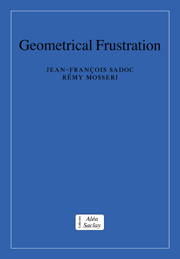Book contents
- Frontmatter
- Contents
- Preface
- 1 Introduction to geometrical frustration
- 2 Ideal models
- 3 Finite structures
- 4 Decurving and disclinations
- 5 Hierarchical polytopes
- 6 Some physical properties
- 7 Periodic structures with large cells
- 8 Quasiperiodic order and frustration
- A1 Spaces with constant curvature
- A2 Quaternions and related groups
- A3 Hopf fibration
- A4 Polytopes and honeycombs
- A5 Polytope {3, 3, 5}
- A6 Frank and Kasper coordination polyhedra
- A7 Quasiperiodic tilings: cut and projection
- A8 Differential geometry and parallel transport
- A9 Icosahedral quasicrystals and the E8 lattice
- Bibliography
- Index
A9 - Icosahedral quasicrystals and the E8 lattice
Published online by Cambridge University Press: 06 January 2010
- Frontmatter
- Contents
- Preface
- 1 Introduction to geometrical frustration
- 2 Ideal models
- 3 Finite structures
- 4 Decurving and disclinations
- 5 Hierarchical polytopes
- 6 Some physical properties
- 7 Periodic structures with large cells
- 8 Quasiperiodic order and frustration
- A1 Spaces with constant curvature
- A2 Quaternions and related groups
- A3 Hopf fibration
- A4 Polytopes and honeycombs
- A5 Polytope {3, 3, 5}
- A6 Frank and Kasper coordination polyhedra
- A7 Quasiperiodic tilings: cut and projection
- A8 Differential geometry and parallel transport
- A9 Icosahedral quasicrystals and the E8 lattice
- Bibliography
- Index
Summary
Introduction
We now consider quasiperiodic structures derived from the eight-dimensional lattice E8. Indeed, using the cut and projection method, it is possible to generate a four-dimensional quasicrystal having the symmetry of polytope {3, 3, 5} (Elser and Sloane 1987). We present here a modified version of this method. The network is foliated into successive shells surrounding a vertex. These shells belong to S7 spheres. We then take advantage of the Hopf fibration of S7, with S3 fibres, to split the E8 sites into symmetrically disposed sets of 24 sites in the S3 fibres. This method has two advantages: first, in the selection process, it is a full fibre which is either selected or rejected, which simplifies this algorithmic step; more important, this selection process eventually amounts to a simple arithmetic criterion. We then get a shell-by-shell analysis of the four-dimensional structure, which recalls in some respects the 2d–1d algorithm used to generate the Fibonacci chain. The number of points on these shells is exactly given. Note finally that, making sections in this quasicrystal, lower-dimensional quasicrystals are obtained, for instance structures with icosahedral or tetrahedral symmetries in three dimensions. Here we will only summarize these different results, the detailed results being found in the reference (Sadoc and Mosseri 1993).
The E8 lattice
The E8 lattice is known to provide the densest sphere packing in eight dimensions; it belongs to the family of ‘laminated’ lattices, and is sometimes denoted Λ8 in this context.
- Type
- Chapter
- Information
- Geometrical Frustration , pp. 286 - 297Publisher: Cambridge University PressPrint publication year: 1999



